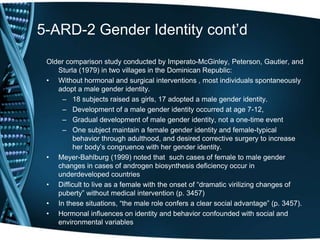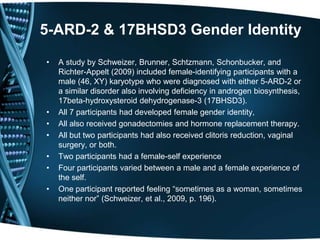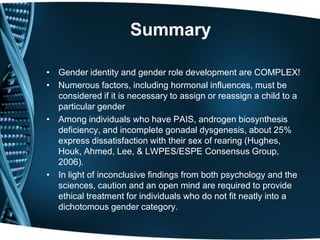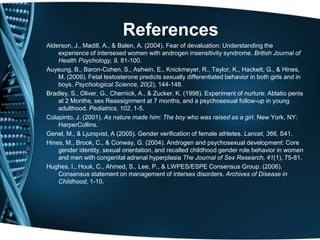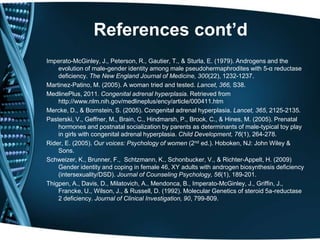Hormonal Influences on Female Gender Identity & Behavior
- 1. Hormonal Influences on Female Gender Identity & Behavior Sue-Mei Slogar Regent University PSYC 260 April 28, 2011
- 2. Can gender identity & behavior be modified by hormones? Note the similarity in the chemical structure of these molecules!
- 3. YES • Successful case of male to female gender reassignment, initiated because of a circumcision injury (ablatio penis) • Surgical castration at 7 months • Hormone (estrogen) replacement therapy (HRT) at 11 years • Occupation involved a male-typical job • No dissatisfaction with sex of rearing & assignment • Two interviews during adolescence and young adulthood found that this individual ―was living socially as a woman and denied any uncertainty about being a female‖ although childhood gender preferences involved male-typical activities and toys (Bradley, Oliver, Chernick, & Zucker, 1998, p. 1).
- 4. NO • Case remarkably similar to that described by Bradley et al. • David Reimer also suffered a botched circumcision and was raised female as a means of managing the injury • Received HRT treatment as well • Never felt like he was a female or fit into the female gender role • Rejected sex of rearing & assignment as a teenager, had reconstructive surgery and assumed a male-typical gender role (Colapinto, 2001) • Possible reason for failed reassignment? – Reimer was reassigned at age 17 mos, and underwent surgical castration and reconstructive surgery (vaginoplasty) at age 21 mos., much later than the case previously described (Bradley et al.,1998)
- 5. MAYBE The following studies highlight the mixed outcome of a variety of hormone-related disorders and exposure to elevated levels of prenatal testosterone.
- 6. Hormonal Influences on Behavior: Testosterone • Elevated levels of prenatal testosterone increases male-typical behavior for both males and females • Behavior/hormonal linkage more pronounced for females than males • Presence of male-typical behavior measured with the Pre-School Activities Inventory (PSAI) • Correlation between PSAI scores and testosterone levels was .42 for girls and .20 for boys (p < 0.05) Auyeung et al., 2009
- 7. Hormonal Influences on Behavior: Congenital Adrenal Hyperplasia • Congenital adrenal hyperplasia (CAH) occurs when the body lacks an enzyme necessary for producing aldosterone and cortisol. This results in an elevated androgen level. This condition affects both genetic males and females (MedlinePlus, 2011) • In one study, 5/16 women (46, XX karyotype) with CAH reported that they had experienced a desire to be male over the past twelve months. • No women from the control group (15) or men from both the CAH and control groups (9 and 10, respectively) experienced gender dysphoria. • 5 women with CAH also reported engaging in homosexual or bisexual behavior in the past twelve months • Control group reported exclusive or nearly exclusive heterosexual behavior • Women with CAH who completed the PSAI (14) reported more male- typical behavior in childhood than women in the control group (11) with an effect size of 1.60 • No differences were found between the CAH and control groups of men • Conclusion: androgens appear to more significantly influence women’s behavior, in comparison to men’s behavior Hines, Brook, and Conway, 2004
- 8. CAH cont’d • Females with CAH have a greater tendency to – Use physical aggression in conflict – Prefer male-typical careers and activities – Demonstrate less interest in mothering • Females with CAH also – Generally demonstrate male-typical patterns of cognitive abilities (spatial and mathematical areas) Mercke & Bornstein, 2005
- 9. CAH cont’d: Socialization • Differences in toy preferences between girls with and without CAH cannot be explained by parental socialization • One study found that parents actually reinforce female-typical play more when daughters have CAH, as compared to normal daughters • Girls without CAH in this study engaged in more female-typical play when alone than when accompanied by either parent • Girls with CAH showed no difference between solo and parent-present play Pasterski et al., 2005
- 10. Androgen Insensitivity Syndrome (AIS) • Individuals with AIS have a 46, XY karyotype—they are genetically male • Feminine secondary sex characteristics develop as a result of insensitivity to androgen; breast development indicates estrogen sensitivity (Rider, 2005) • Experiences of individuals with partial & complete AIS: – Psychological complications, feelings of a compromised womanhood • Lack of reproductive capabilities and/or masculine appearance – Sense of devaluation • Fear of others’ negative perceptions • Rejection • Lessened value as a partner – The most salient finding is that individuals with AIS view themselves as women, but experience difficulties because of fear that society’s perception will not match their self-perceptions. Alderson, Madill, and Balen, 2004
- 11. AIS: Incongruence between Self- Identity & Society’s Perspective • Problem of ethical treatment of female athletes – Female Olympic athletes were required to take a sex chromatin test that detected their 46, XY karyotype, although these individuals were described as ―undeniably female‖ – Clinical assessment required to remain in the competition (Genel and Ljungvist, 2005, S41) – Genetic testing only discontinued in the year 2000 – One female athlete was pressured to drop out of the competition and refused. Her experience of discrimination and humiliation of because of AIS: • When I crossed the line first in the 60 m hurdles, my story was leaked to the press. I was expelled from our athletes’ residence, my sports scholarship was revoked, and my running times were erased from my country’s athletics records. I felt ashamed and embarrassed. I lost friends, my fiancé, hope, and energy. But I knew that I was a woman, and that my genetic difference gave me no unfair physical advantage. I could hardly pretend to be a man; I have breasts and a vagina. I never cheated. I fought my disqualification (Martinez-Patino, 2005, S38).
- 12. Androgen Biosynthesis Deficiencies: 5-ARD-2 & 17BHSD3 • Individuals with 5-Alpha Reductase-2 Deficiency (5-ARD-2) are genetically male, that is, they have a karyotype of 46, XY. • Male gender identity reported to develop at puberty, although sex of rearing was female (Rider, 2005). • The gene responsible for the presence of 5-ARD-2 is named the 5a-reductase type 2 gene or SRD5A2 (Thigpen et al., 1992). • Thigpen et al. (1992) found that depending on the specific mutation of SRD5A2, individuals with 5-ARD-2 might demonstrate a more feminine or masculine phenotype. – Substitution of arginine for glycine at position 34 in SRD5A2 ―resulted in a female phenotype with only minor virilization expected at puberty‖ (p. 802). – Another participant in this study had a mutation in SRD5A2 involving a serine existing where glycine would normally be present at position 196. This resulted in ―a predominantly male phenotype‖ (p. 802). • These results ―suggested a correlation between clinical expression and severity of the impairment of enzyme [5-alpha reductase] function‖ (p. 804). •
- 13. 5-ARD-2: Gender Identity • Thigpen et al., 1992: • Some participants were raised as female and retained a female gender identity • Some raised as female and adopted a male gender identity • Some raised as male and retained male identity • Participants also received varying combinations of surgery and female hormones – Difficult to separate effects of disease from effects of treatment
- 14. 5-ARD-2 Gender Identity cont’d Older comparison study conducted by Imperato-McGinley, Peterson, Gautier, and Sturla (1979) in two villages in the Dominican Republic: • Without hormonal and surgical interventions , most individuals spontaneously adopt a male gender identity. – 18 subjects raised as girls, 17 adopted a male gender identity. – Development of a male gender identity occurred at age 7-12, – Gradual development of male gender identity, not a one-time event – One subject maintain a female gender identity and female-typical behavior through adulthood, and desired corrective surgery to increase her body’s congruence with her gender identity. • Meyer-Bahlburg (1999) noted that such cases of female to male gender changes in cases of androgen biosynthesis deficiency occur in underdeveloped countries • Difficult to live as a female with the onset of ―dramatic virilizing changes of puberty‖ without medical intervention (p. 3457) • In these situations, ―the male role confers a clear social advantage‖ (p. 3457). • Hormonal influences on identity and behavior confounded with social and environmental variables
- 15. 5-ARD-2 & 17BHSD3 Gender Identity • A study by Schweizer, Brunner, Schtzmann, Schonbucker, and Richter-Appelt (2009) included female-identifying participants with a male (46, XY) karyotype who were diagnosed with either 5-ARD-2 or a similar disorder also involving deficiency in androgen biosynthesis, 17beta-hydroxysteroid dehydrogenase-3 (17BHSD3). • All 7 participants had developed female gender identity, • All also received gonadectomies and hormone replacement therapy. • All but two participants had also received clitoris reduction, vaginal surgery, or both. • Two participants had a female-self experience • Four participants varied between a male and a female experience of the self. • One participant reported feeling ―sometimes as a woman, sometimes neither nor‖ (Schweizer, et al., 2009, p. 196).
- 16. Summary • Gender identity and gender role development are COMPLEX! • Numerous factors, including hormonal influences, must be considered if it is necessary to assign or reassign a child to a particular gender • Among individuals who have PAIS, androgen biosynthesis deficiency, and incomplete gonadal dysgenesis, about 25% express dissatisfaction with their sex of rearing (Hughes, Houk, Ahmed, Lee, & LWPES/ESPE Consensus Group, 2006). • In light of inconclusive findings from both psychology and the sciences, caution and an open mind are required to provide ethical treatment for individuals who do not fit neatly into a dichotomous gender category.
- 17. References Alderson, J., Madill, A., & Balen, A. (2004). Fear of devaluation: Understanding the experience of intersexed women with androgen insensitivity syndrome. British Journal of Health Psychology, 9, 81-100. Auyeung, B., Baron-Cohen, S., Ashwin, E., Knickmeyer, R., Taylor, K., Hackett, G., & Hines, M. (2009). Fetal testosterone predicts sexually differentiated behavior in both girls and in boys. Psychological Science, 20(2), 144-148. Bradley, S., Oliver, G., Chernick, A., & Zucker, K. (1998). Experiment of nurture: Ablatio penis at 2 Months, sex Reassignment at 7 months, and a psychosexual follow-up in young adulthood. Pediatrics, 102, 1-5. Colapinto, J. (2001). As nature made him: The boy who was raised as a girl. New York, NY: HarperCollins. Genel, M., & Ljunqvist, A (2005). Gender verification of female athletes. Lancet, 366, S41. Hines, M., Brook, C., & Conway, G. (2004). Androgen and psychosexual development: Core gender identity, sexual orientation, and recalled childhood gender role behavior in women and men with congenital adrenal hyperplasia The Journal of Sex Research, 41(1), 75-81. Hughes, I., Houk, C., Ahmed, S., Lee, P., & LWPES/ESPE Consensus Group. (2006). Consensus statement on management of intersex disorders. Archives of Disease in Childhood, 1-10.
- 18. References cont’d Imperato-McGinley, J., Peterson, R., Gautier, T., & Sturla, E. (1979). Androgens and the evolution of male-gender identity among male pseudohermaphrodites with 5-α reductase deficiency. The New England Journal of Medicine, 300(22), 1232-1237. Martinez-Patino, M. (2005). A woman tried and tested. Lancet, 366, S38. MedlinePlus, 2011. Congenital adrenal hyperplasia. Retrieved from http://www.nlm.nih.gov/medlineplus/ency/article/000411.htm Mercke, D., & Bornstein, S. (2005). Congenital adrenal hyperplasia. Lancet, 365, 2125-2135. Pasterski, V., Geffner, M., Brain, C., Hindmarsh, P., Brook, C., & Hines, M. (2005). Prenatal hormones and postnatal socialization by parents as determinants of male-typical toy play in girls with congenital adrenal hyperplasia. Child Development, 76(1), 264-278. Rider, E. (2005). Our voices: Psychology of women (2nd ed.). Hoboken, NJ: John Wiley & Sons. Schweizer, K., Brunner, F., Schtzmann, K., Schonbucker, V., & Richter-Appelt, H. (2009) Gender identity and coping in female 46, XY adults with androgen biosynthesis deficiency (intersexuality/DSD). Journal of Counseling Psychology, 56(1), 189-201. Thigpen, A., Davis, D., Milatovich, A., Mendonca, B., Imperato-McGinley, J., Griffin, J., Francke, U., Wilson, J., & Russell, D. (1992). Molecular Genetics of steroid 5a-reductase 2 deficiency. Journal of Clinical Investigation, 90, 799-809.

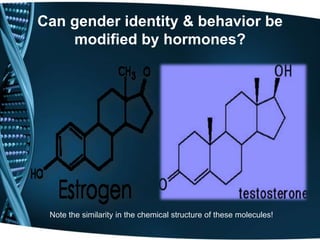

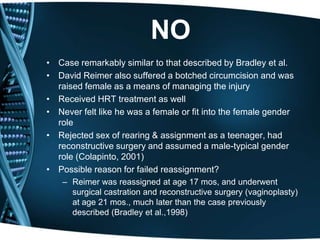


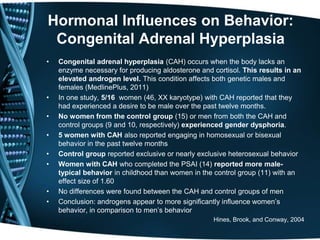
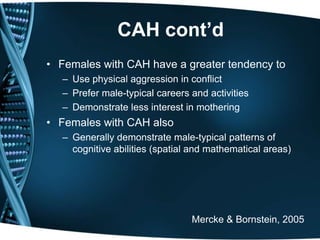

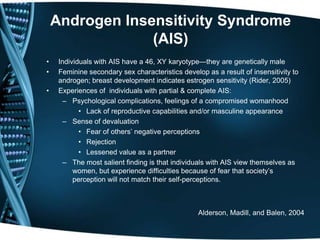
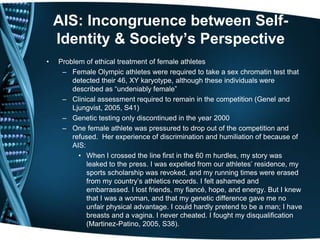
![Androgen Biosynthesis Deficiencies:
5-ARD-2 & 17BHSD3
• Individuals with 5-Alpha Reductase-2 Deficiency (5-ARD-2) are genetically
male, that is, they have a karyotype of 46, XY.
• Male gender identity reported to develop at puberty, although sex of rearing
was female (Rider, 2005).
• The gene responsible for the presence of 5-ARD-2 is named the 5a-reductase
type 2 gene or SRD5A2 (Thigpen et al., 1992).
• Thigpen et al. (1992) found that depending on the specific mutation of
SRD5A2, individuals with 5-ARD-2 might demonstrate a more feminine
or masculine phenotype.
– Substitution of arginine for glycine at position 34 in SRD5A2 ―resulted in
a female phenotype with only minor virilization expected at puberty‖ (p.
802).
– Another participant in this study had a mutation in SRD5A2 involving a
serine existing where glycine would normally be present at position 196.
This resulted in ―a predominantly male phenotype‖ (p. 802).
• These results ―suggested a correlation between clinical expression and
severity of the impairment of enzyme [5-alpha reductase] function‖ (p.
804).
•](https://image.slidesharecdn.com/slogarpsyc260presentation-13387679356519-phpapp01-120603190158-phpapp01/85/Hormonal-Influences-on-Female-Gender-Identity-amp-Behavior-12-320.jpg)

